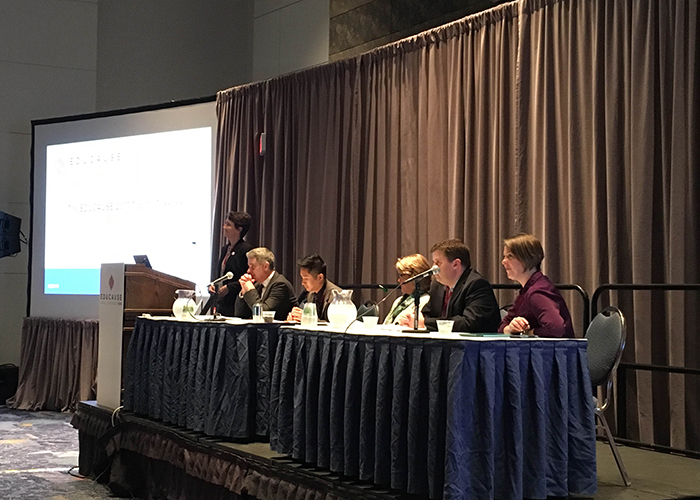EDUCAUSE 2016: Security Still the Top Issue for Higher Education IT
Once again, security tops the list of higher education IT professionals’ concerns heading into 2017, based on EDUCAUSE’s annual survey about the industry’s most pressing issues. Susan Grajek, EDUCAUSE’s vice president of data, research and analytics, presented the Top 10 IT Issues list on Wednesday at the EDUCAUSE 2016 conference. Results are based on stakeholders’ input and votes by organization members.
Although security is a persistent presence, three new issues were included on the list this year: strategic leadership, next-generation enterprise IT and higher education affordability. The affordability question came up throughout the year among EDUCAUSE members who convene quarterly to discuss issues, Grajek said.
“This notion that institutions can and need to do more with IT than ever, and yet there are resource limitations — how do we prioritize? How do we work with institutional leadership to help them set priorities so we can focus and deliver real value?” Grajek said.
Of the EDUCAUSE members who helped to identify key themes for 2017, four sat on a panel to discuss the results on Wednesday: Marden Paul, director of planning, governance and assessment at the University of Toronto; Gerard Au, associate vice president of IT services at California State University, San Bernardino; John Landers, Project Management Office leader at Case Western Reserve University; and Rebecca Frost Davis, director for instructional and emerging technology at St. Edward’s University.
2017 Top 10 IT Issues
- Information security: Developing a holistic, agile approach to reducing institutional exposure to information security threats
- Student success and completion: Effectively applying data and predictive analytics to improve student success and completion
- Data-informed decision-making: Ensuring that business intelligence, reporting and analytics are relevant, convenient and used by administrators, faculty and students
- Strategic leadership: Repositioning or reinforcing the role of IT leadership as a strategic partner with institutional leadership
- Sustainable funding: Developing IT funding models that sustain core services, support innovation and facilitate growth
- Data management and governance: Improving the management of institutional data through data standards, integration, protection and governance
- Higher education affordability: Prioritizing IT investments and resources in the context of increasing demand and limited resources
- Sustainable staffing: Ensuring adequate staffing capacity and staff retention as budgets shrink or remain flat and as external competitions grows
- Next-generation enterprise IT: Developing and implementing enterprise IT applications, architectures and sourcing strategies to achieve agility, scalability, cost-effectiveness and effective analytics
- Digital transformation of learning: Collaborating with faculty and academic leadership to apply technology to teaching and learning in ways that reflect innovations in pedagogy and the institutional mission
Marden Paul of the University of Toronto; Gerard Au of California State University, San Bernardino; Susan Grajek of EDUCAUSE; John Landers of Case Western Reserve University; and Rebecca Frost Davis of St. Edward’s University speak at the EDUCAUSE conference on Wednesday. Photo by Amy Burroughs.
Findings Represent Complex IT Challenges
Next-generation enterprise IT, one of the new entries on the annual list, is a broad area that focuses on integrating a wide range of solutions and resources, Au said. Although new tools deliver solid benefits, they also bring a host of challenges. Taking cloud-based solutions as an example, he said, “How do we manage all these resources? How is IT going to be managing all the vendors? What is your university’s exit strategy if you have to switch from one to another? It’s a multilevel and multifaceted approach to infrastructure.”
The panelists also discussed the potential, and the limitations, of the “digital transformation of learning,” No. 10 on the list. Too often, Davis said, institutions view the latest tech solution as a fix that checks the “digital transformation” box. But simply offering online content delivery or having a few innovative faculty members on staff isn’t enough to truly change the way an institution approaches learning, she said.
“We’re talking about partnering with technology to solve complex problems, and this is something we need to integrate into curriculum, but also into the culture and business of the university,” Davis said.
Paul agreed: “Digital transformation is not just organizational change and it’s not just technology — it’s the merger of those to change the way you do business.”
The issue of data management and governance, No. 6 on the list, reflects a growing interest in developing and leveraging data analytics to improve academic and operational performance. Yet a major challenge persists, Paul said, in the fact that data is often unreliable and difficult to integrate. Too often, he said, institutions do not pay enough attention to data standards.
“There’s a need for people to understand what happens to the data they touch once it gets downstream,” he said. Without that, he said, data may be unusable for other applications, which leads to distrust of the quality of the information.
“If people start to rely on their own local information gathering and don’t rely on authoritative sources, then the authoritative sources are no longer authorative, at which point the great collective hope we have — that data will solve all our problems — becomes less useful,” Paul said. “It’s important to remind people that everything they touch now connects to something else.”
Together, the emerging challenges and capabilities affecting higher education signify a stronger and more strategic role for IT leaders going forward, panelists agreed.
“IT really needs to be a partner on campus,” Au said. “The conversation is changing on how an IT organization can be a partner on anything and everything that our campuses do.”
To stay up to date on all of the news and ideas coming out of EDUCAUSE, follow EdTech's coverage on the EDUCAUSE 2016 conference hub.










